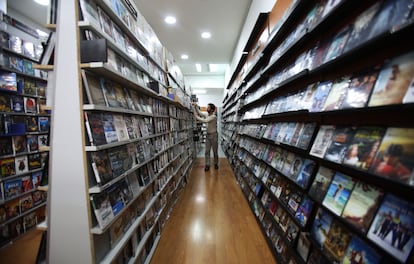Commentary, behind-the-scenes features, bloopers: What did we lose when we said goodbye to DVDs?
Fewer and fewer movies and TV series are being released in physical format, but streaming platforms do not provide enough for some film buffs, who miss the extras they offered

Years ago, a movie collection could be found in any home. No collection was the same, but each resembled its owner’s film tastes. But as physical copies of movies are displaced by digital streaming platforms, what exactly has been lost?
“I’m a physical copy fetishist, as you can see,” jokes film critic Kyle Turner on a video call with EL PAÍS. Behind him in his New York apartment, there are shelves filled with colorful DVDs, alongside books about art and, of course, cinema.
“When I was much younger, I spent more time watching the DVD extras than the movie itself: the commentaries, the behind-the-scenes features, the documentaries, the music videos, even the bloopers!” says Turner, author of The Film Queer Guide and contributor to The New York Times and GQ. Like many millennial film buffs, the DVD extras gave him his first lessons in film. “They helped you understand the director’s intentions or the techniques used during production, and I really miss that.”
The extra material was one of the ways to buy or rent movies, first on DVD and then on Blu-ray. This format included commentaries from the filmmakers, in-depth explanations of the production process and interviews. Some even had music videos, basic games or small surprises that invited you to navigate from start to finish through what initially appeared as nothing more than an interface to press play or change the language.
Many of these physical copies, in their documentary zeal, also curated special material that is now difficult to find. “The rights to this extra content expire and the only way to access it is through alternative means, including unreliable websites, since it is no longer essential for the consumption of the film, series, or franchise,” says the film critic, who feels that streaming platforms, with few exceptions, have not found a way to compensate for this loss.
Beyond providing more insight into the different elements of a production, the extras could change the way you watched a film. An edition of Christopher Nolan’s Memento, for example, allowed you to watch the entire film in chronological order, while with Blade Runner, you could watch all five versions of the film that have ever existed and will exist, which change the nature of Harrison Ford’s character. “Having a whole universe on one disc is something I miss,” says Turner.
A universe on a single disk
“DVDs were revolutionary in the late 1990s,” says Turner, who notes that the DVD’s predecessor, the LaserDisc, did not have a menu. “They incorporated into a home video format an interface used in video games or computer programs.”
One of the most memorable features was the art and design of the menus, which allowed viewers to navigate through the different options offered by each disc. Rather than simply listing options and commands, the designers used the technology available to make the menu an experience of its own. The goal was — to use a very 1990s word — to be “multimedia.”
Turner points out that, like the palatial movie theaters of the first half of the 20th century, DVD and Blu-ray menus helped ease the transition between everyday reality and the world of the screen. However, it was neither an easy nor a simple task.
A 2023 article in The Guardian recounts that for the teams in charge of producing DVD menus, it was like the “wild west.” A place without clear rules, but with the maxim of convincing the viewer that the disc in their hands was a unique experience. Thomas Fletcher, who worked on the first DVD to be released in the United States, told The Guardian that directors were often involved in the design of DVD menus, providing comments and observations.
The most memorable menus impeccably reflected the logic and aesthetics of the film or series in question. This was the case with the special Blu-ray edition of Fight Club, for example, which pretends to be a copy of a Drew Barrymore film before turning into the David Fincher movie. Or the two-disc edition of Monty Python and the Holy Grail, which offered “subtitles for people who don’t like the film,” in which the British comedy’s dialogue is replaced by verses from William Shakespeare’s Henry IV, Part II. One of the most remembered DVD menus is from Rob Zombie’s House of 1000 Corpses, in which the character of Captain Spaulding (Sid Haig) insults the viewer for not being able to decide which option to choose.
Turner is clear about his favorite DVD menus: “The ones from a James Bond collection made in the early 2000s.” The film critic is far from the only one who’s nostalgic. A quick search on YouTube reveals that there are plenty of DVD menu fans: a tour of the Shrek 2 DVD menu has more than 2.5 million views, while another video, which navigates through the menu options for The Simpsons Movie, has more than 900,000.
The change from DVD to Blu-ray in the late 2000s also led to an evolution in menu design. Turner says that, despite having greater capacity, graphical interfaces became more and more minimalist. “The notion of making the menu part of the movie experience was lost there,” the film critic notes. “The Blu-ray edition I have of Nights of Cabiria, one of my favorite movies, doesn’t have a menu. It just starts and to choose the extra content, like the documentary or the commentary, you have to select it from a list that appears when you pause the movie.” However, the big change for home entertainment was yet to come.
Mastering the digital
“I think that in the days of DVDs, the product was not just about offering a film, but about selling a sensation,” the film critic reflects. “There is no longer that desire to expand a universe, and I must admit that it is something I am nostalgic for. As the presentations become more minimalist, it becomes clear that they are nothing more than products that are being sold to us.”
“There’s a big difference between scrolling through an endless list of movies on a grid and actually holding it in your hand,” adds Turner. However, the public has a clear preference for the digital. The Statista website indicates that the number of people who watched a series or a movie in physical copy fell sharply between 2019 and 2024. In the United States and the United Kingdom, it sank, respectively, from 49% and 47% to 29% and 28%.
Turner notes that some streaming platforms like Disney Plus supplement their series and films with extra material, such as documentaries, but he believes that these substitutes do not yet work as well as the physical releases. “I think that the way of browsing on many of these platforms does not offer the same thing, they simply direct you to the film and there is almost no way to explore beyond what they give you,” says Turner, who believes that seeing a list of movies with their names and posters is reminiscent of the experience of buying online.
Meanwhile, some DVD and Blu-ray distributors have struck deals to release movies and shows that were previously exclusively digital. “There are firms like Criterion, Arrow, Kino or Shout Factory that do special editions and seem to be doing very well despite the dominance of streaming over physical media,” Turner argues. “They have taken the initiative to put out quality products where you really get value for money.”
“It’s interesting to see what people choose to release physically and what they don’t. These platforms have hundreds and hundreds of titles at their disposal, but their distributors tend to be very selective when it comes to deciding what to bring to physical format.” Turner recalls the case of Mike Flanagan, creator of the Netflix series The Haunting of Hill House and, more recently, The Fall of the House of Usher. The American director wrote on his blog in 2023 that he “was disappointed” that Netflix did not want to release the productions he had made for the streaming platform on DVD and Blu-ray.
Will DVDs and Blu-rays of TV shows and movies become collector’s items, like vinyl records? Turner leaves the answer to viewers: “I think audiences now have the choice between a reliable, if imperfect, content system like streaming, where you don’t know when or how long something will be available, or investing in and developing their own collection.”
Sign up for our weekly newsletter to get more English-language news coverage from EL PAÍS USA Edition
Tu suscripción se está usando en otro dispositivo
¿Quieres añadir otro usuario a tu suscripción?
Si continúas leyendo en este dispositivo, no se podrá leer en el otro.
FlechaTu suscripción se está usando en otro dispositivo y solo puedes acceder a EL PAÍS desde un dispositivo a la vez.
Si quieres compartir tu cuenta, cambia tu suscripción a la modalidad Premium, así podrás añadir otro usuario. Cada uno accederá con su propia cuenta de email, lo que os permitirá personalizar vuestra experiencia en EL PAÍS.
¿Tienes una suscripción de empresa? Accede aquí para contratar más cuentas.
En el caso de no saber quién está usando tu cuenta, te recomendamos cambiar tu contraseña aquí.
Si decides continuar compartiendo tu cuenta, este mensaje se mostrará en tu dispositivo y en el de la otra persona que está usando tu cuenta de forma indefinida, afectando a tu experiencia de lectura. Puedes consultar aquí los términos y condiciones de la suscripción digital.
More information
Archived In
Últimas noticias
Chris Martin, Taylor Swift, Elijah Wood and other famous wedding ‘crashers’
‘How does it feel to be a failure?’: Elizabeth Berkley’s journey from ‘Showgirls’ ridicule to vindication
The story of the Málaga virus: The code that haunted Google’s cybersecurity center director for 30 years
The impact of Ecuador’s mega-prison: A polluted river, cleared forests and military checkpoints
Most viewed
- Christian Louboutin: ‘Young people don’t want to be like their parents. And if their parents wear sneakers, they’re going to look for something else’
- The low-cost creative revolution: How technology is making art accessible to everyone
- Liset Menéndez de la Prida, neuroscientist: ‘It’s not normal to constantly seek pleasure; it’s important to be bored, to be calm’
- All the effects of gentrification in one corner of Mexico’s Colonia Roma
- December Social Security and SSI payments: Dates, double checks and the 2026 COLA increase










































